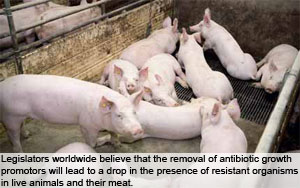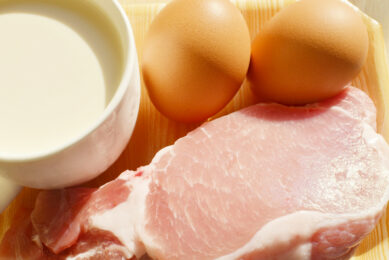A primacy in science and education – Part 3. Antibiotic-free animal production

Over a decade ago, Denmark was the first country to ban the use of antibiotic growth promoters (AGPs). Ever since, a European ban followed. Now is a good time to reflect on how to permit animals to achieve their peak potential.
By Aidan Connolly
When the AGP ban was implemented, the harbingers of doom were pessimistic about the future of European animal production. While producers have survived, it is clear that tough decisions have still not been taken with regard to fully meeting consumer and regulator expectations. In addition, the expertise of growing animals without the presence of sub-therapeutic growth promoting antibiotics is no longer confined to the EU with producers in Brazil and the US possessing similar if not more knowledge. Has an opportunity been missed by the European market and where to now for antibiotic-free production?
The European Union decision by then commissioner Dr David Byrne, to apply the ‘precautionary principle’ with regard to the continuous use of low levels of antibiotics in the diets of animals was followed by similar measures in a range of other countries from Brazil to Korea, Chile to Turkey.On 28 June 2010, the FDA in the United States published a report entitled ‘The judicious use of medically important antimicrobial drugs in food producing animals’. Legislators worldwide believe that the removal of these drugs will lead to a drop in the presence of resistant organisms in both the live animals and in their meat, milk and egg produce. Studies have now been carried out in Denmark, Germany and the Netherlands to map the presence of antibiotic resistance. These suggest that while resistance in animals has not been eliminated, it has certainly diminished.
Since 2003 however, Danmap (Danish Integrated Antimicrobial resistance Monitoring & Research Programme ) reports a worrying trend, firstly an explosion in the application of macrolides as therapeutic drugs (up 150%) and more recently, tetracyclines where consumption per pig produced has increased by 118% from 2003 to 2008. Interestingly, three-quarters (76%) of the increase in tetracyclines for weaning pigs was ascribed to just 504 herds, where there are ten or more treatments per year, leading Danmap to suspect systematic routine prescriptions.Denmark is not alone. Anecdotal reports suggest a widespread increase in the use of therapeutic antibiotics in most of the other EU countries since the AGP ban. This is at variance with the Commission’s original objectives and has led to other initiatives by governments to name and shame persistent offenders, both by targeted efforts at farm level and also identifying specific veterinarians. Using both legal and societal means to exert pressure on individuals suggests that the battle to restrict the use of antibiotics is far from over.
Zinc oxide
Additionally, the widespread use of other compounds, for example pharmacological doses of zinc oxide in pig diets, suggests that the reality of living without antimicrobials has not yet been fully confronted. Clearly antibiotic resistance is a very complex issue. It was reported at a FDA-sponsored meeting last year that tetracycline resistant organisms have been found in feral pigs off the coast of North Carolina where contact with humans has been minimal and indicates that bacteria endemically carry resistant genes to a wide range of antimicrobials or biologically similar compounds. The persistence of resistance has been reported also by the University of Kentucky. They maintained a herd of pigs – antibiotic free – and frequently evaluated antibiotic resistance. Twenty years later the prevalence of significant levels of resistant microorganisms was still being recorded. Some work with mannan oligosaccharides (MOS) suggest that this can be cured.
Questioning AGP use
The ubiquitous use of antibiotics as growth promoters prompted a variety of authors to question why these compounds were chosen in the first place. Rosen’s review in 1995 of 12,153 studies with antibiotic growth promoters confirmed positive responses being seen in 72% of cases. This compares to similar reviews carried out more recently on (i) the use of enzymes based on 1,322 publications from 1992-1999 (Rosen, 2003a) and (ii) a holo-analyses on the use of mannan oligosaccharides on pigs, broilers and turkeys based on databanks of 241 negatively controlled tests where positive responses were seen (Rosen, 2005 a,b,c,d).
In general, animals fed subclinical levels of antibiotics grow 2-4% faster, requiring less feed and with lower overall mortality. Benefits in poultry are also said to include a decrease in necrotic enteritis (NE) although a survey by Elanco (Elanco, 2000) suggested that the cost of NE varies globally from US$.045 to US$.05 per bird, a small variation given that this survey included both countries and companies that were using antibiotics for growth promotion and those that were antibiotic-free. It would appear that natural programmes are capable of meeting this challenge.
Magic bullet
The first step for many producers following restrictions on the use of AGPs has been the desire to replace them with a single compound. In particular, the use of mannan oligosaccharides (MOS) essential oils, enzymes, organic acids and organically complexed minerals has grown dramatically.
Over 600 studies have reported benefits with mannan oligosaccharides (Bio-Mos, Alltech) in 17 species of animals and this is now the most accepted intervention for both poultry and pigs. These studies suggest that maintaining intestinal health and immune function are the primary benefits associated with MOS. Other forms of oligosaccharides benefit animals primarily as fermentable substrates to promote populations of beneficial intestinal microflora. Fahey’s (2003) work in both pigs and dogs with 15 of these oligosaccharides suggests that effective doses are over 1% of the diet, which is considerably higher than those being used commercially today.
Probiotic strains such as bacillus are growing in acceptance and have addressed some of the EU concerns about the toxicity of the metabolites they produce. Enzyme studies frequently mix re-formulation strategies by adding the enzyme on top of a nutrient sufficient diet. One of the postulated benefits of using enzymes to promote growth in the absence of AGPs is the removal of substrates from the intestine which favour the proliferation of pathogenic bacteria. Organic acids have gained widespread acceptance in EU pig production. In particular, fumaric and phosphoric acids are being used at levels of up to 2% of the feed during the weaning period but this can create other challenges, not least in relation to nutrient formulation. More concentrated and complex acid products certainly show potential, particularly when applied through water. Essential oils and plant extracts have promised much but delivered less than expected. Quality control on the active ingredients, which are often toxic if used in their pure form, is problematic at best. In an article by Kist, Traesel and others, published in this April’s issue of Comparative Clinical Pathology, it was stated that the effective growth promotion dose of oregano, rosemary, sage and chili pepper and the associated “increase in serum levels of lipase, uric acid, urea, and aspartate aminotransferase… may cause kidney and liver impairment.” Challenges also exist regarding the stability of the active ingredients in the feed production process due to their volatility. Overall, the review by McCartney (2005) still is an effective five-point test to evaluate any alternatives when being used as a single option.
The future is now
Work in the US is confirming the benefits of a structured approach to the challenge of maximising growth without AGPs. At the Western Poultry Disease conference in April 2010, Stephen R. Collett confirmed that, “We can grow antibiotic-free (ABF) poultry today with similar performance to what we have been achieving where growth promoters were used.”
Such an approach requires multiple interventions and not the reliance on a single product approach. ABF programmes in the US typically include the use of organic acids in the drinking water both for young animals and during periods of known stress. Specific probiotic strains are sprayed on day-old chicks to minimise the entry of pathogens, including salmonella, E.coli and Clostridia. Enzyme complexes work most effectively when formulation changes are made, reducing overall protein and energy levels, allowing for expected nutrient release. Industry leaders now use enzymes produced using solid state fermentation and have observed that lowering crude protein can lead to benefits for both intestinal health and pathogen load. The global market for organically complexed minerals, of selenium, zinc, copper and manganese, is growing at over 30% a year. For example, the product Sel-Plex (CNCM I-3060) has demonstrated clear benefits for breeding animals, their offspring and lifetime performance. The product’s acceptance has resulted in greater interest in exploring organically bioplexed minerals. Finally, the use of mannan oligosaccharides continues to grow, for poultry, pigs, calves and aquaculture, with new, more specific bioactive fractions being cracked from yeast, such as the recently launched product Actigen.
Ten years later – where next?
Antibiotic-free programmes and natural growth promotion continue to be a leading topic in the marketing of meat, eggs and milk. In addition, this topic continues to feature heavily in scientific literature and meetings. While some may despair that the progress has been slower than expected – and that antibiotics continue to be used to safeguard against poor management and on-farm challenges – it seems that a programme approach, availing of multiple new technologies used simultaneously, is the one with the most chance of success.











